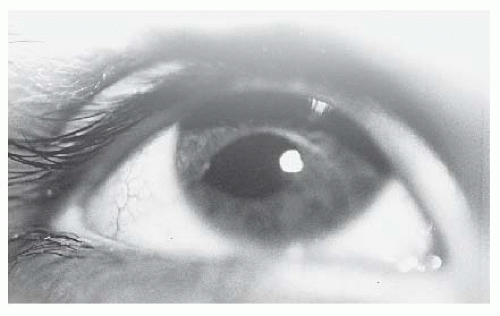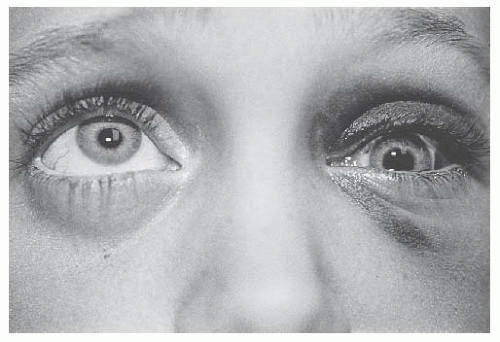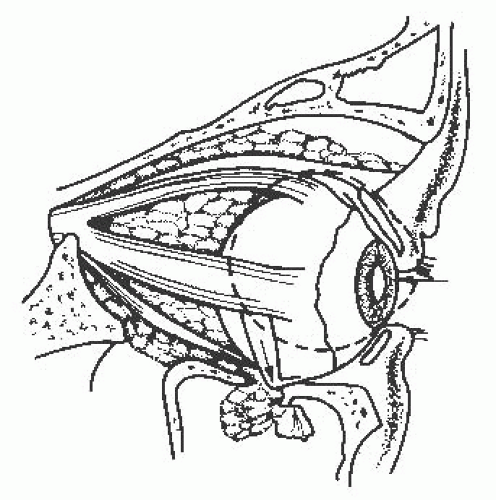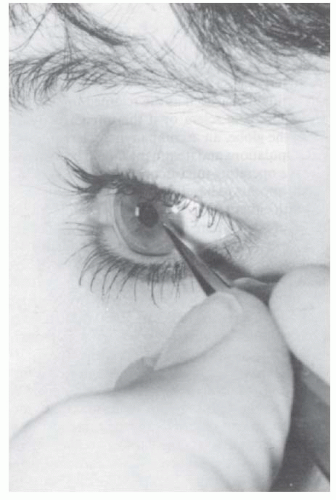Ocular Trauma and Its Prevention
Robert A. Catalano
A SIGNIFICANT PROPORTION of ocular injuries occur in children. According to the Agency for Healthcare Research and Quality, approximately 28% of Emergency Department visits related to eye injuries in 2008 were for patients younger than 18 years of age. Further, the 2010 Annual Eye Injury Snapshot Project estimated that approximately 12% of all eye injuries occur in children 12 years of age or younger (1,2). The more recent U.S. data is consistent with previously published European data that the highest proportion of severe eye injuries in children occurs in the home (40% to 45%), followed by injuries sustained while playing sports or due to a motor vehicle accident (approximately 15%). In children younger than age 6 years, domestic accidents (scissors, pencils, or other sharp objects) were the principal cause; in older children, toy, stone, and ball injuries predominated (3). This study and others (4,5,6) revealed a substantial male preponderance and noted that most severe injuries in children are accidental and caused by another child.
In contrast with other causes of childhood visual loss, such as from congenital and/or hereditary diseases in which current treatments may be less effective, victims of ocular trauma can often benefit greatly by prompt treatment. Even greater benefit can be had if ocular trauma is prevented, which is readily attainable in the pediatric population.
HISTORY
Although most ophthalmologic office examinations for children require only a brief history, when ocular trauma is apparent or suspected, a complete and detailed history is essential, especially when a responsible adult did not observe the injury. In many cases, the initial history is the most accurate and unbiased. Extra care and attention to detail is required to detect prevarication or other attempts at deception; for example, the child may have sustained the trauma engaged in a proscribed behavior, a “supervising” adult may have been involved in the injury, or the visual loss, if any, may have predated the injury. In addition, careful documentation of all historical and objective findings, with detailed drawings or photographs, if indicated, can be crucial for purposes of determining civil liability and/or suspected child abuse.
When the patient’s chief complaint is trauma, the usual sequence of questions for history taking must be greatly expanded. Precise determination of the time and place of the onset of symptoms or signs must be made. A foreign body sensation that began when the child was near a construction site prompts a search for a different type of object than if the symptoms began in a wooded area. When the inciting event is not obvious, and the symptoms and signs did not begin at a distinct time, inquiry must be made of activities in the preceding hours, days, or even weeks.
The child’s precise activity at the time of injury and the site where it occurred must be determined. Whether or not the child was wearing glasses, using high-speed motorized equipment, and whether or not anyone was hammering are examples of the level of detail that must be documented. If a wild animal inflicted the injury, the animal should undergo pathologic examination of its brain to look for signs of rabies infestation. When such examination is impossible, consultation with local health officials should be sought to determine the need for rabies prophylaxis.
The general medical history must also be determined. Known medical problems, hospitalizations, prior ocular and nonocular surgeries, current medications of all types, medicinal allergies, and family history must all be explored. In addition, patients with open wounds must have their tetanus prophylaxis history reviewed and reimmunization administered, if necessary.
EXAMINATION
Despite the critical need for as complete an examination as possible to make an accurate diagnosis, initial efforts must be directed to the more important goal of preventing further injury. In the case of a ruptured globe, a more complete examination is always obtained with the child anesthetized in the operating room, which significantly reduces the risk of further injury. Complicating an already difficult situation is pain and discomfort, reducing what may be an already low level of cooperation. Extra efforts at cajoling or bribery, additional pairs of strong hands, a papoose board, local nerve
block, sedation, or even anesthesia may be required alone or in combination for proper diagnosis and treatment.
block, sedation, or even anesthesia may be required alone or in combination for proper diagnosis and treatment.
Protection from Further Injury
When definitive treatment for the injury will occur later, the injured eye and adnexa should be protected from further inadvertent trauma. Lid retraction, forced opening of the eyelids and removal of a protruding foreign body is absolutely contraindicated, and topical drops of any kind should not be applied. With lid lacerations, foreign bodies, and suspected ruptured globes, a standard eye shield should be taped to the orbital rim to protect the globe and eyelids, and the head of the bed should be elevated to 30 degrees. When ophthalmic supplies are unavailable, a disposable Styrofoam coffee cup can be cut about 2.5 cm (1 inch) from its base and used for the same purpose.
From a systemic standpoint, a child with a possibly ruptured globe may be agitated, nauseated (from a vasovagal reflex), or both. Mild sedation, along with an antiemetic, may be indicated to prevent further damage. The child should be kept NPO for possible surgery, and ambient light should be reduced. If there is concern that the child may pull off a protective eye shield, elbow or other restraints may be necessary.
When a ruptured globe is repaired under general anesthesia, a nondepolarizing agent should be used (7). Depolarizing agents (e.g., succinylcholine) transiently raise intraocular pressure with possible further extrusion of intraocular contents.
Special Studies
Additional modalities of examination may be required in some instances. When motorized equipment or high-speed impacts (e.g., hammering) were involved at the time of the injury, a foreign body, either in the globe or orbit, must be suspected. An intraocular foreign body should also be considered whenever a ruptured globe is suspected. Plain radiographic films and/or noncontrast computed tomography (CT) with 1 to 2 mm axial and coronal cuts through the orbits (8,9) should be taken for accurate and precise localization. Magnetic resonance imaging (MRI) should never be used if there is any possibility of a metallic foreign body.
CT scanning is not sufficiently sensitive or specific when an occult open-globe injury is suspected. When an occult injury is suspected a formal surgical examination should be performed in the operating room (10).
If a clear view of the fundus is not obtained, ultrasonography should be considered to assess retinal integrity. However, the diagnostic possibility of a ruptured globe is a contraindication to the use of ultrasound. In this instance, any pressure on the globe may further disrupt the anatomy and cause retinal and/or uveal prolapse, and the nonsterile probe raises the risk of infection. For closed-globe injuries, ultrasound biomicroscopy is particularly superior to other methods in the evaluation of the zonular status, angle recession, cyclodialysis, and the detection of small superficial and intraocular foreign bodies (11).
Prognosis
Open-globe injuries result in the worst visual outcomes in children with ocular trauma (12). Particularly unfavorable outcomes are also related to an initial presentation of hyphema, vitreous hemorrhage, retinal detachment, and/or a corneal wound across the pupil (13). The presence of a relative afferent pupillary defect and poor initial visual acuity are the most predictive indicators of complete loss of vision and the presence of lid laceration and posterior wound location also predict poor visual outcome (14). Children with an ocular injury sustained during major trauma (multiple injuries with an Injury Severity Score > 15) are more likely to have a basilar skull fracture and/or orbital wall fracture (15). The subsequent development of endophthalmitis also portends a poor visual prognosis. A standardized protocol of 48 hours of intravenous vancomycin and ceftazidime upon admission resulted in a posttraumatic endophthalmitis rate of less than 1% in a recent study (16).
BIRTH AND PRENATAL TRAUMA
Significant ocular injuries occur in approximately 0.2% of deliveries, particularly forceps-assisted deliveries (17). The most widely recognized finding associated with birth trauma is a vertically oriented rupture of Descemet’s membrane, which is often accompanied by a hazy cornea (17). Horizontal Descemet’s ruptures (Haab’s striae) result more commonly from the high intraocular pressure of congenital glaucoma. Although direct contact of forceps with the cornea is usually implicated, periocular compression is also a possible mechanism of injury (18).
With time, epithelial edema fades, leaving a vertical line at the level of Descemet’s membrane. This line is visually insignificant. However, true ruptures of Descemet’s membrane can lead to very large degrees of astigmatism that can result in anisometropic amblyopia (19). The initial corneal haziness can also act as a form of occlusion, which can induce axial myopia and exacerbate the anisometropia (20). The use of a rigid contact lens to neutralize the astigmatism and aggressive occlusion therapy can possibly improve the visual prognosis (21).
Perinatal periocular ecchymoses (22), lid (23) or canalicular (24) lacerations, ptosis (25), corneal edema (22), hyphema (22), and multiple retinal hemorrhages (22) have also been reported. Small retinal hemorrhages usually resolve in 1 to 5 days and subconjunctival hemorrhages within 2 weeks (17). Injuries to the lid that cause ptosis are potentially very serious because the ptosis may cause an axial myopia (20), which can lead to an anisometropic amblyopia.
In addition to corneal injury, forceps delivery may rarely result in choroidal ruptures, even in the absence of external signs of injury (26). Finally, ocular adnexal birth injury by a fetal monitoring scalp electrode has been reported occasionally (27).
INJURIES TO THE LIDS AND ADNEXA
Ecchymosis of the Eyelid
Most orbital contusions, due to blunt injuries, cause soft tissue damage with little or no disability. Blunt trauma, however, can be associated with a blowout or other orbital fractures, hyphema, angle recession, iridodialysis, retinal edema, and retinal breaks. Deep orbital bleeding can cause compression of the optic nerve or ophthalmic artery. Examination of the peripheral retina, using scleral depression, may have to wait until orbital edema subsides. The examination should not be delayed, however, in patients with symptoms suggestive of a retinal tear.
The distribution of hemorrhage can occasionally foretell a serious orbital injury. Blood under the superior conjunctiva suggests an orbital roof fracture, especially when accompanied by significant eyelid edema and ecchymosis (31). Basilar skull fractures are sometimes associated with a ring-like distribution of periorbital blood. Hemorrhage in the lower lid and inferior orbit may signal an orbital floor fracture (Fig. 24.2).
Blunt trauma can also result in ptosis secondary to a hematoma of the eyelid or levator palpebrae muscle. A permanent ptosis can result if the aponeurosis is stretched or torn. Fingers or hooks caught under the upper eyelid often result in this type of injury.
Treatment of lid ecchymosis consists of cold compresses for the initial 24-hour period, followed by warm compresses as needed.
Lid Laceration
In addition to obvious causes of lacerations from injury with sharp objects and animal bites, lid lacerations can be caused by strong blows with blunt objects, such as an elbow in a competitive basketball game. The initial evaluation of a lid laceration of any etiology is directed at the integrity of the globe; vision-threatening ocular injuries take precedence over those involving only the lids, where delayed repair may still give an excellent cosmetic and functional result. With lacerations involving the medial portion of the lid, the status of the canaliculi should be determined to the greatest extent possible without risking further injury.
There is no clear consensus concerning prophylactic treatment with antibiotics for lid lacerations. Although standard surgical practice may suggest use of antibiotics in other injuries, they may not be necessary with lid lacerations due to the rich blood supply of the lids.
Most children who sustain ophthalmic trauma are not sufficiently cooperative to allow for local or regional anesthetic techniques. Regardless of the level of cooperation, general anesthesia is mandatory whenever related injuries require its use, as in an ocular laceration.
Primary, edge-to-edge closure remains the mainstay of treatment for lid lacerations. Nonrepair of a torn canaliculus may be considered when only one canaliculus is involved (32), but when both canaliculi are involved, intubation of the canaliculi with Silastic tubing looped and brought out through the lower opening of the nasolacrimal duct increases the chance of functional success. Subsurface absorbable sutures are then used around the cut edges of the canaliculi before the cutaneous edges are repaired. Even with a complete history, a thorough search for a retained foreign body should be made at the time of repair of any laceration. The reader is referred elsewhere for detailed, specific recommendations on treatment, which are beyond the scope of this chapter.
ORBITAL TRAUMA
Blowout Fracture of the Orbital Floor
Orbital apex, lateral wall, and Le Fort type III fractures have a greater association with severe ocular injuries than blowout fractures of the orbital floor, but they occur less commonly (33). The term direct orbital floor fracture describes an orbital floor fracture associated with an orbital rim fracture. Much greater force is needed to fracture the orbital rim than to fracture the orbital floor. The term indirect orbital floor fracture describes an isolated orbital floor fracture and is known more commonly as a blowout fracture. Two theories have been developed to explain the pathogenic mechanism of a blowout fracture. The first maintains that these fractures result when the intraorbital pressure is suddenly elevated by a nonpenetrating blunt force. The orbital tissues are compressed, and the weakest part of the orbit, the 0.5- mm-thick orbital floor just below the inferior rectus muscle, becomes the avenue of decompression (Fig. 24.3). A more recent theory suggests that a blunt force applied to the inferior orbital rim compresses the bone and causes a buckling of the orbital floor. Orbital floor fractures are common when objects larger than the orbital opening, such as a ball, a fist, or the dashboard of an automobile, impact the orbit, particularly the inferior lateral orbit. Macaca monkey experiments have suggested that forces greater than 2 joules (J) are needed to produce an orbital floor fracture, and that orbital wall fractures fail to protect the globe from rupture (34).
The most apparent clinical sign of an orbital floor fracture is a limitation of upward gaze (Figs. 24.2 and 24.4). A concomitant limitation of downward gaze, however, is a more certain indication of inferior rectus or oblique muscle entrapment. Entrapment is more likely to occur when an articulated bone fragment acts like a trap door, restricting the movement of the inferior rectus or oblique muscle. This occurs most frequently with small, indirect orbital floor fractures, and most commonly the inferior rectus muscle, posterior to its adventitial connection to the inferior oblique muscle, is involved. Additional signs are lid ecchymosis, epistaxis, orbital emphysema, and hypesthesia of the ipsilateral cheek and upper lip, which results from disruption of the infraorbital nerve as it traverses the orbital floor. Enophthalmos results from expansion of the orbital volume and is an overt sign of an orbital floor fracture. It occurs more commonly with direct orbital floor fractures but it may not become apparent until orbital edema resolves. Exophthalmos from orbital edema, hematoma, or inflammation is more likely to be present acutely.
The best imaging techniques to visualize an orbital floor fracture are plain film radiography and CT scanning. The optimal plain film projection is the Waters’ view because it demonstrates the orbital floor and maxillary sinus best (Fig. 24.5). An orbital floor fracture is suggested by the prolapse of orbital contents into the maxillary sinus, an air-fluid level in the
sinus, or orbital emphysema. Although the Waters’ view is suggested for screening, direct, coronal 1.5- to 2-mm CT scanning should be obtained, if surgical repair is contemplated, because this provides more soft tissue and bone fragment detail.
sinus, or orbital emphysema. Although the Waters’ view is suggested for screening, direct, coronal 1.5- to 2-mm CT scanning should be obtained, if surgical repair is contemplated, because this provides more soft tissue and bone fragment detail.
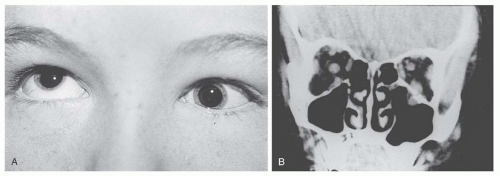 FIGURE 24.4. Blowout fracture of the left eye in a 12-year-old girl who was kicked in the eye by a classmate. A: Limitation of upgaze. B: Coronal CT scan showing tissue entrapment. |
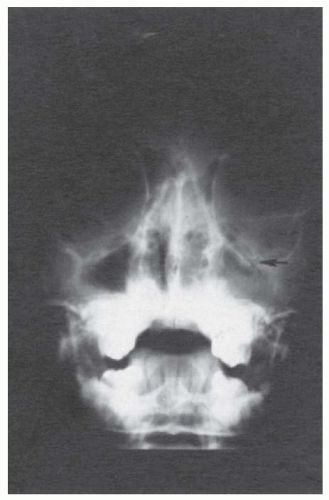 FIGURE 24.5. Waters’ view demonstrating blowout fracture of the orbital floor. (From Catalano RA, ed. Ocular emergencies. Philadelphia, PA: WB Saunders Co, 1992, with permission.) |
The indications for and timing of surgical repair of a blowout fracture continue to evolve (35,36). The radiographic presence of fracture alone is not an indication for surgery nor is the sole finding of infraorbital hypesthesia. Generally accepted indications for repair include a motility disturbance due to extraocular muscle entrapment (within 30 degrees of the primary position) or enophthalmos. In pediatric patients, symptoms of entrapment of the inferior rectus muscle include pain, nausea, and vomiting. Surgical repair rapidly relieves these symptoms (37). Surgical intervention for a limitation of motility is based on true mechanical restriction, suggested by persistent positive forced traction testing and confirmed radiographically. It should be remembered, however, that techniques other than floor fracture repair (prisms, strabismus surgery) might be effective in relieving diplopia. Enophthalmos of greater than 2 mm generally requires repair, because it is usually cosmetically unacceptable. Because the necessary exposure of an orbital floor fracture places pressure on the globe, the presence of a penetrating ocular injury is an absolute contraindication to orbital floor repair.
The timing of surgical repair is also controversial. A blowout fracture never needs emergent treatment. Most ophthalmologists agree that surgery can be safely delayed for 10 to 14 days without risking the development of scarring or fibrosis. The passage of several days is usually needed to allow orbital swelling to subside enough to perform an adequate clinical examination. An indication for early surgical repair is the presence of enophthalmos greater than 2 mm or hypoglobus in the acute stage of an orbital floor fracture. Orbital edema and hematoma usually mask the early appearance of enophthalmos; its acute presence indicates a substantial extrusion of orbital contents into the maxillary sinus. Surgery within 2 weeks is recommended in cases of symptomatic diplopia with positive forced ductions and evidence of orbital soft tissue entrapment on CT Scan (38).
Additional therapeutic measures in the acute setting are antibiotic prophylaxis to prevent an orbital cellulitis, nasal decongestants, and ice packs.
INJURIES TO THE GLOBE
Injuries to the Conjunctiva and Sclera
A subconjunctival hemorrhage commonly accompanies blunt trauma (Fig. 24.6). In the absence of other injury, an affected patient is treated with reassurance alone. The hemorrhage may appear to become larger over the first several days. This occurs as gravity and the weight of the eyelid smooth out blood clots that can dissect under normal conjunctiva. Rarely, if ever, does a subconjunctival hemorrhage rebleed. The blood gradually resorbs over 2 to 3 weeks.
Conjunctival edema (chemosis) can accompany a minor injury. However, its presence raises the suspicion of scleral rupture or a retained foreign body. Air under the conjunctiva (emphysema) suggests fracture through the ethmoid
or maxillary sinus. Emphysema appears cystic and causes crepitus on palpation.
or maxillary sinus. Emphysema appears cystic and causes crepitus on palpation.
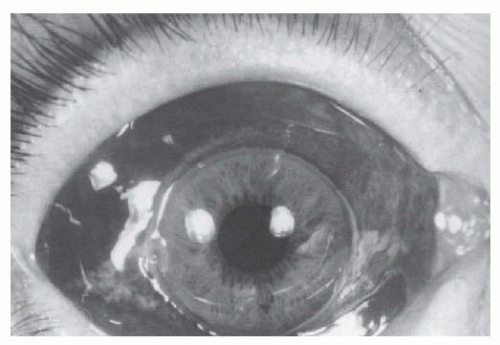 FIGURE 24.6. Traumatic subconjunctival hemorrhage. (From Catalano RA, ed. Ocular emergencies. Philadelphia, PA: WB Saunders Co, 1992, with permission.) |
A laceration of the conjunctiva is especially common when a sharp object, such as a fingernail or glass, strikes the eye. In addition to conjunctival hemorrhage, prolapse of whitish-appearing Tenon’s tissue or orbital fat may be evident. A complete examination to rule out a retained foreign body or an occult scleral laceration or is necessary. Ophthalmoscopy through maximally dilated pupils and ultrasound can be used to rule out the former. If sliding the conjunctiva does not allow adequate visualization to rule out a scleral laceration, the physician should not hesitate to conduct an examination under anesthesia or obtain imaging studies. Small conjunctival lacerations do not need suturing, but lacerations greater than 6 mm should be closed with absorbable suture (e.g., 7-0 plain gut), taking care not to incorporate Tenon’s tissue in the wound. One should also respect the normal anatomical relationship of the caruncle and semilunar fold in the repair. The unrepaired conjunctival defect heals within 2 to 3 weeks.
Occult scleral rupture can occur with blunt trauma, especially at the limbus and just posterior to the rectus muscle insertions, where the sclera is weakest (39). In addition to a bullous conjunctival hemorrhage and chemosis, signs of rupture include an asymmetrical reduction in intraocular pressure, shallowing or deepening of the anterior chamber, irregularity or peaking of the pupil, hyphema, decreased visual acuity, and subconjunctival pigmentation. The last is due to prolapsed uveal tissue at the site of rupture. In suspected cases, as much as a 360-degree conjunctival peritomy should be performed (incising the conjunctiva at the limbus and retracting it posteriorly to expose the underlying sclera), with particular attention directed to the area under the rectus muscle insertions.
Corneal Foreign Bodies and Abrasions
Corneal and conjunctival foreign bodies are very common causes of acute ocular pain and foreign body sensation. Patients typically present with excruciating pain and a reflexive inhibition to opening their eye. They may or may not recall an object falling or flying into their eye, and their pain may or may not be immediate or may wax and wane. Although inert objects may cause little or no secondary changes, organic material can produce a severe reaction (Fig. 24.7).
The cornea and bulbar conjunctiva are examined directly with or without magnification. The palpebral conjunctiva of the lower eyelid and the inferior cul-de-sac can be examined by pulling down the lower eyelid and having the patient look up. Examination of the palpebral conjunctiva of he upper eyelid and the upper cul-de-sac is more difficult. “Double eversion” of the upper eyelid may be required. A single eversion of the upper eyelid can be achieved by gently grasping the eyelid at the lash line and pulling it down while placing minimal counterpressure at the upper border of the eyelid with a cotton-tipped applicator. The patient should be instructed to look down during the procedure. Elevation of the lid margin, counterpressure at the upper border, and gentle lid rotation usually everts the lid (Fig. 24.8). “Double eversion” of the upper eyelid is accomplished by substituting a Desmarres retractor for the cotton-tipped applicator and pulling the eyelid forward as it is rolled around the retractor (Fig. 24.9). A careful search for a foreign body is then made of both the palpebral conjunctiva and the cul-de-sac. Upper lid eversion produces discomfort, which can be minimized by instructing the patient to look down continually.
If a foreign body is found, it can usually be easily removed. Adequate anesthesia is obtained with topical anesthetics (proparacaine 0.5% or tetracaine 0.5%). One drop is usually adequate, but additional applications at intervals of 3 to 5 minutes may be necessary. Young children may require generous amounts of vocal reassurance, or, if it is unsuccessful, sedation or a brief general anesthesia.
Before the removal of a foreign body in the conjunctiva, the underlying sclera should be examined to rule out a penetrating injury. If the conjunctiva, as well as the retained foreign body, is not easily movable over the underlying sclera, or, if the foreign body appears fixed to deeper structures of the globe, an accompanying scleral injury should be suspected. Further manipulations and treatment should be carried out in the operating room, under the operating microscope.
 FIGURE 24.8. Eversion of upper eyelid with cotton applicator. (From Catalano RA, ed. Ocular emergencies. Philadelphia, PA: WB Saunders Co, 1992, with permission.) |
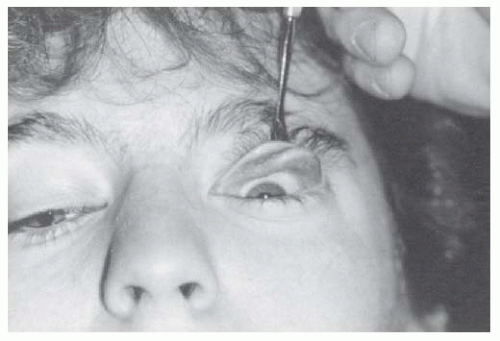 FIGURE 24.9. “Double” eversion of upper eyelid with Desmarre’s retractor. (From Catalano RA, ed. Ocular emergencies. Philadelphia, PA: WB Saunders Co, 1992, with permission.) |
If the foreign body appears to be adherent to only the cornea or conjunctiva, it can be removed with a foreign body spud, fine forceps (jewelers or tying forceps), or the edge of a medium-bore needle (22-gauge). This is best done at the slit lamp with the physician’s hand resting on the patient’s cheekbone. This position lessens the chance of striking the globe with a sharp object; any movement of the patient is automatically followed by the physician’s hand (Fig. 24.10). Many foreign bodies can also be removed by applying a bland ophthalmic ointment (Lacri-Lube, Duratears) to the end of a cotton-tipped applicator and swabbing the foreign body, a safer approach to use when a slit lamp is not available. Although this technique removes loose or recently occurring foreign bodies, it is less effective with foreign bodies that have been present for a longer duration and have become more adherent. Once a conjunctival foreign body is removed, further treatment is usually not indicated. Once a corneal foreign body is removed, the treatment should follow the guidelines outlined later for corneal abrasions. Iron-containing corneal foreign bodies often leave a deposit of rust that may spread into the deeper layers of the cornea. The residual rust often resolves with time but can cause persistent foreignbody-like complaints. The rust ring can be scraped with a dull object, like a foreign body spud, or removed with a mechanical corneal bur (a battery-operated low-speed drill).
A corneal abrasion is one of the most common ocular complaints seen in an emergency setting. The epithelium covering the cornea is distinct in morphology and function from the conjunctival epithelium, with which it is continuous. When the corneal epithelium is scratched, abraded, or denuded, it exposes the underlying basement layer and superficial corneal nerves. This is accompanied by pain, tearing, and photophobia. Extensive abrasions can also cause a significant drop in visual acuity because the underlying layers do not offer the same smooth, reflective surface as
the normal corneal epithelium. The diagnosis can usually be made by penlight alone, when the usual smooth, glistening tear film overlying the epithelium is disrupted. If possible, slit-lamp confirmation to determine the depth of the abrasion is indicated. Minute amounts of fluorescein dye, with or without the use of a cobalt-60 filtered light source, can also be used for confirmation and exact delineation.
the normal corneal epithelium. The diagnosis can usually be made by penlight alone, when the usual smooth, glistening tear film overlying the epithelium is disrupted. If possible, slit-lamp confirmation to determine the depth of the abrasion is indicated. Minute amounts of fluorescein dye, with or without the use of a cobalt-60 filtered light source, can also be used for confirmation and exact delineation.
The treatment of corneal abrasions is directed at promoting healing and relieving pain. Small abrasions can be treated with frequent applications of topical antibacterials (drops or ointment) with or without immobilization of the lid with a patch. In children, an antibiotic ointment is generally preferred because it does not have to be administered as frequently and stings less than drops. Steroid preparations are contraindicated as they slow epithelial healing and increase susceptibility to secondary infection.
Larger abrasions usually require lid immobilization for comfort, but controlled studies have not demonstrated any difference in the rate of healing or in reported discomfort with or without eye patching (40,41). Applying a small ribbon of 2.5-cm (1-inch) tape horizontally across the lash margin may be a simpler yet effective method of stabilizing the lid (Fig. 24.11) without patching. In young children, pressure patches should be avoided as they are typically quickly pulled off by the child. In addition, patients with contact-lens-related abrasions should never be patched because they are much more susceptible to infectious keratitis from pathogens initially residing on the contact lens or in lens solutions. It is theorized that the increased temperature under the patch and patient’s decreased ability to monitor their visual acuity also contribute to the increased risk of infection in these patients (42).
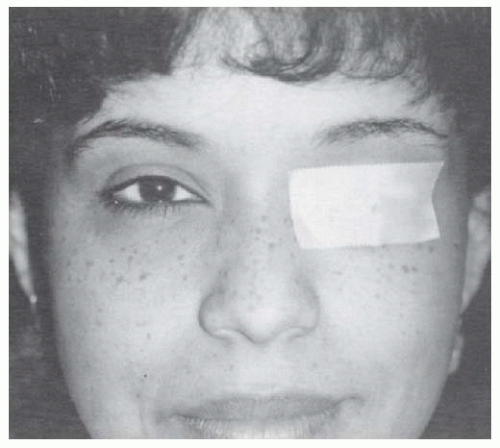 FIGURE 24.11. Immobilization of eyelids with 1-inch tape across eyelid margins. (From Catalano, RA, ed. Ocular emergencies. Philadelphia, PA: WB Saunders Co, 1992, with permission.) |
Most corneal abrasions completely heal within 24 to 72 hours. Patients with larger abrasions should be followed until epithelial healing has occurred, and antibiotics should be continued until the eye is symptom free for 24 hours. If a patch is used, it should not be left in place longer than 24 hours. Topical anesthetics result in almost immediate relief of pain but are toxic to the epithelium. There is no indication for their prolonged use. Ophthalmic nonsteroidal anti-inflammatory drugs and cycloplegia are better choices to reduce the pain associated with simple corneal abrasion, and they do not delay healing (43).
Thermal and Chemical Burns of the Cornea
Almost all foreign substances that enter the eye cause a burning sensation, but heat and chemicals can produce a sustained burn injury to the eye. Alkalis saponify phospholipid membranes leading to epithelial cell death and deep penetration into the eye. Acids damage the eye by causing a coagulation necrosis that can result in corneal scarring and ulceration (44). The ultimate vision with a burn to the eye is highly dependent on the initial treatment rendered. Immediate irrigation with copious amounts of moderately
warm water at low pressure for at least 30 minutes is the mainstay of the initial (in the field) treatment of chemical burns. In the hospital, amphoteric buffer solutions, Ringer’s lactate or normal saline is typically used as the irrigant, and a Morgan lens may be used to keep the flow directed onto the eye (45). The “normal” pH of the eye ranges from 6.5 to 8.0. During irrigation, the pH should be reassessed every 15 minutes using pH paper and if only one eye is affected, the pH of the uninvolved eye should be measured for comparison. Depending on the chemical, irrigation may need to be continued for hours and the pH should be assessed 5 and 30 minutes after irrigation to ensure that the chemical has been flushed completely. Topical analgesia with proparacaine or tetracaine is often used adjunctively, and the eyelids should be everted and fornices should be swept to dislodge any retained chemical.
warm water at low pressure for at least 30 minutes is the mainstay of the initial (in the field) treatment of chemical burns. In the hospital, amphoteric buffer solutions, Ringer’s lactate or normal saline is typically used as the irrigant, and a Morgan lens may be used to keep the flow directed onto the eye (45). The “normal” pH of the eye ranges from 6.5 to 8.0. During irrigation, the pH should be reassessed every 15 minutes using pH paper and if only one eye is affected, the pH of the uninvolved eye should be measured for comparison. Depending on the chemical, irrigation may need to be continued for hours and the pH should be assessed 5 and 30 minutes after irrigation to ensure that the chemical has been flushed completely. Topical analgesia with proparacaine or tetracaine is often used adjunctively, and the eyelids should be everted and fornices should be swept to dislodge any retained chemical.
Corneal and Corneoscleral Lacerations
Lacerations of the globe can be caused by injuries with sharp objects or by high-energy blunt objects smaller than the orbital opening. Many injuries of the latter type occur in sports and recreation (e.g., with a fast-moving ball in a racket sport) and are entirely preventable.
The goals of therapy are the restoration of normal anatomy and the prevention and treatment of complicating factors, such as infection and glaucoma. In young children, however, a significant complicating condition can be amblyopia, and the ultimate visual outcome is heavily dependent on its management (46,47).
Standard ophthalmic surgical practices prevail in the management of pediatric corneal and corneoscleral lacerations. A complete systemic evaluation to look for other injuries should be undertaken, especially if other injuries would preclude prompt treatment of the ocular injury or require concomitant treatment while the patient is anesthetized. Treatment with broad-spectrum antibiotics as a prophylactic measure should be initiated immediately.
Stay updated, free articles. Join our Telegram channel

Full access? Get Clinical Tree


